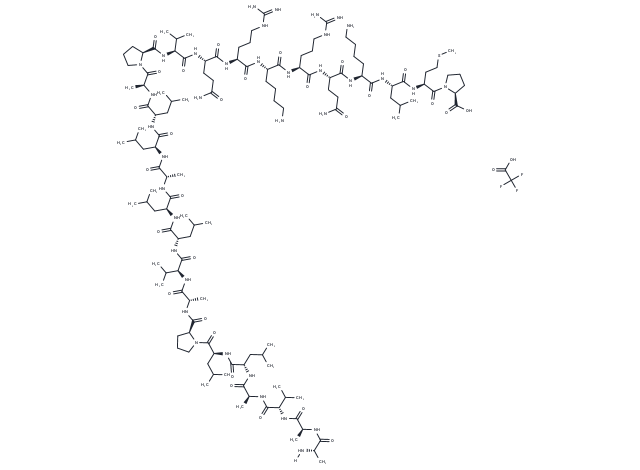Shopping Cart
- Remove All
 Your shopping cart is currently empty
Your shopping cart is currently empty

SN50 TFA is a cell-permeable inhibitor of NF-κB and attenuates alveolar hypercoagulation and fibrinolysis inhibition in acute respiratory distress syndrome mice through inhibiting NF-κB p65 translocation. SN50 TFA can be used in studies about ARDS.

| Pack Size | Price | Availability | Quantity |
|---|---|---|---|
| 500 μg | TBD | 35 days | |
| 1 mg | TBD | 35 days | |
| 5 mg | TBD | 35 days |
| Description | SN50 TFA is a cell-permeable inhibitor of NF-κB and attenuates alveolar hypercoagulation and fibrinolysis inhibition in acute respiratory distress syndrome mice through inhibiting NF-κB p65 translocation. SN50 TFA can be used in studies about ARDS. |
| Alias | SN50 trifluoroacetate, SN50 TFA (213546-53-3 free base), NF-κB Inhibitor TFA |
| Molecular Weight | 2781.5 (free base) |
| Formula | C129H230N36O29S.XCF3COOH |
| Smiles | [H]N[C@H](C(N[C@H](C(N[C@@H](C(C)C)C(N[C@H](C(N[C@@H](CC(C)C)C(N[C@@H](CC(C)C)C(N1CCC[C@H]1C(N[C@H](C(N[C@@H](C(C)C)C(N[C@@H](CC(C)C)C(N[C@@H](CC(C)C)C(N[C@H](C(N[C@@H](CC(C)C)C(N[C@@H](CC(C)C)C(N[C@H](C(N2CCC[C@H]2C(N[C@@H](C(C)C)C(N[C@@H](CCC(N)=O)C(N[C@@H](CCCNC(N)=N)C(N[C@@H](CCCCN)C(N[C@@H](CCCNC(N)=N)C(N[C@@H](CCC(N)=O)C(N[C@@H](CCCCN)C(N[C@@H](CC(C)C)C(N[C@H](C(N3CCC[C@H]3C(O)=O)=O)CCSC)=O)=O)=O)=O)=O)=O)=O)=O)=O)=O)C)=O)=O)=O)C)=O)=O)=O)=O)C)=O)=O)=O)=O)C)=O)=O)C)=O)C.OC(C(F)(F)F)=O |
| Storage | store at low temperature | store at -20°C | Shipping with blue ice. |
| Solubility Information | DMF: 30 mg/mL, Sonication is recommended. PBS (pH 7.2): 5 mg/mL, Sonication is recommended. DMSO: 30 mg/mL, Sonication is recommended. Ethanol: 50 mg/mL, Sonication is recommended. |

Copyright © 2015-2025 TargetMol Chemicals Inc. All Rights Reserved.